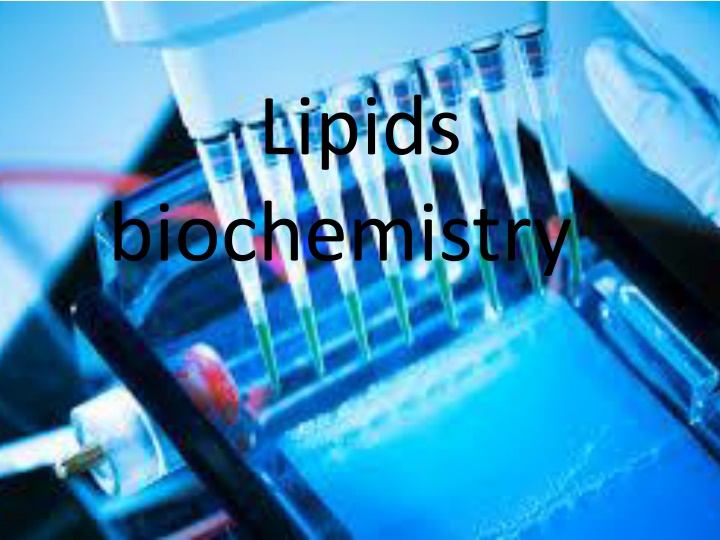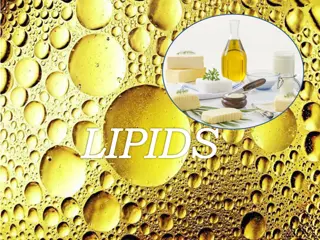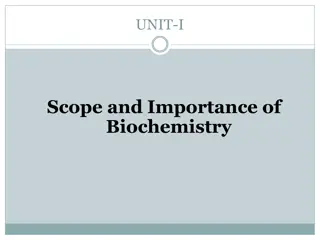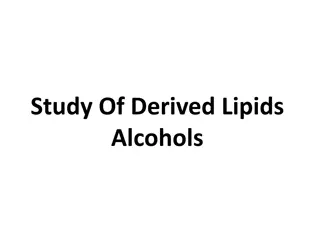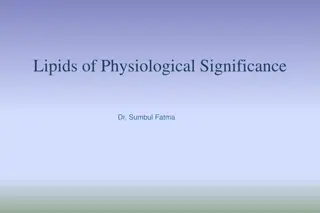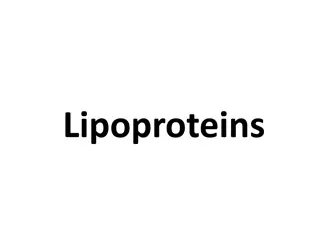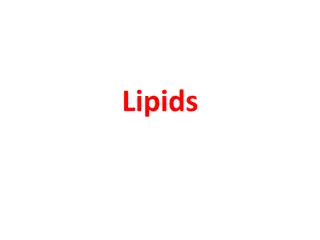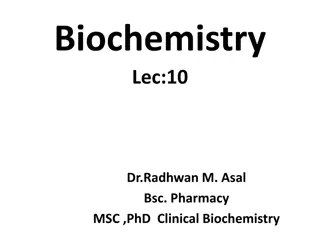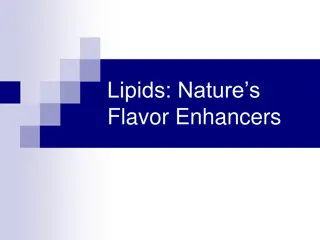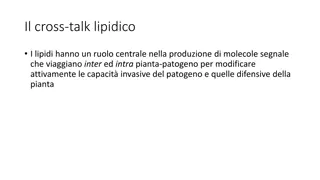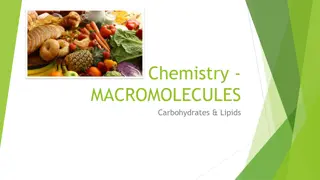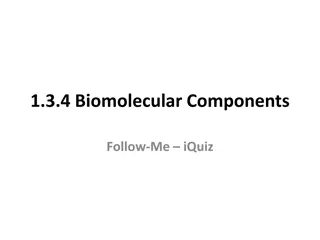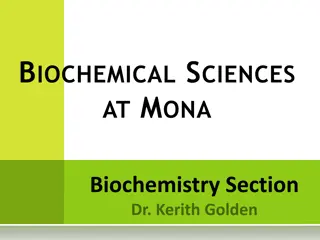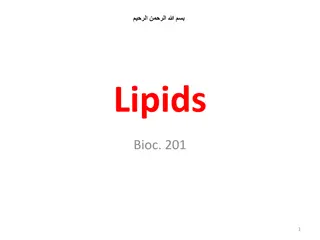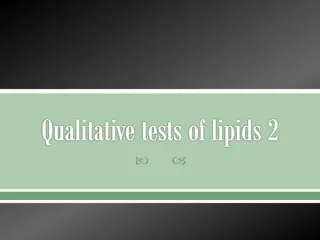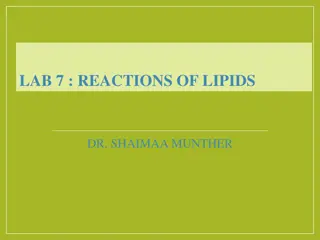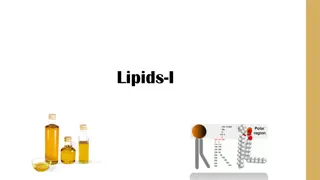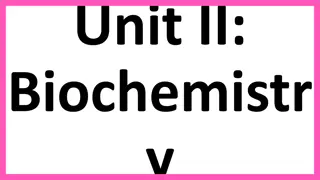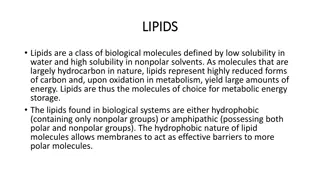Overview of Lipids in Biochemistry
Lipids are essential molecules in biochemistry, consisting of various classes such as fatty acids and cholesterol. They play crucial roles in cellular functions, including energy storage, insulation, and structural components of membranes. Saturated versus unsaturated fatty acids and the hydrolysis of lipids are key aspects to understand. Explore the functions and classes of lipids, as well as their amphipathic nature and metabolic roles. Check out the images provided for a visual representation of lipid structures.
Uploaded on Apr 29, 2025 | 3 Views
Download Presentation

Please find below an Image/Link to download the presentation.
The content on the website is provided AS IS for your information and personal use only. It may not be sold, licensed, or shared on other websites without obtaining consent from the author.If you encounter any issues during the download, it is possible that the publisher has removed the file from their server.
You are allowed to download the files provided on this website for personal or commercial use, subject to the condition that they are used lawfully. All files are the property of their respective owners.
The content on the website is provided AS IS for your information and personal use only. It may not be sold, licensed, or shared on other websites without obtaining consent from the author.
E N D
Presentation Transcript
Lipids biochemistry
Lipids amphipathic small molecules that may originate entirely or in part by carbanion-based condensations of thioesters (fatty acids, polyketides, etc.) and/or by carbocation-based condensations of (phenols, sterols, etc.). are hydrophobic or isoprene units
The most common lipid classes in nature consist of fatty acids linked by an ester bond to the dihydric alcohol - glycerol, or to other alcohols cholesterol, or by amide bonds to sphingoid bases, or on occasion to other amines. such as
Functions of Lipids 1. 2. and cholesterol) 3. Metabolic prostaglandins) 4. Act as surfactants, detergents and emulsifying agents (amphipathic lipids) 5. Act as electric insulators in neurons 6. Provide insulation against temperature (subcutaneous fat) 7. Give shape and contour to the body 8. Protect internal organs by providing a cushioning effect (pads of fat) 9. Help in absorption of fat soluble vitamins (A, D, E and K) 10. Improve taste and palatability to food. Storage form of energy (triglycerides) Structural components of bio-membranes phospholipids regulators (steroid hormones and changes in external
Lipids hydrolysis are called saponifiable lipids. Lipids that don t undergo such reaction nonsaponifable lipids. that undergo alkaline are called
Saturated Vs. unsaturated fatty acids saturated: the SFA s of a lipid have no double bonds between carbons in chain polyunsaturated: more than one double bond in the chain most common polyunsaturated polyunsaturated fatty acids (PUFAs) oleic, linoleic and linolenic acid unsaturated fats have lower melting points stearic (SFA) melts at 70oC, oleic (PUFA) at 26oC fats contain the
Triacylglycerol They consist of a glycerol moiety with each hydroxyl group esterified to a fatty acid. In nature, they are synthesised by enzyme systems, which determine that a center of asymmetry is created about carbon-2 of the glycerol backbone, enantiomeric forms, i.e. with different fatty acids in each position. so they exist in
Cholesterol Sterols and sterol esters: Cholesterol is by far the most common member of a group of steroids in animal tissues; it has a tetracyclic ring system with a double bond in one of the rings and one free hydroxyl group. It is found both in the free state, where it has maintaining membrane fluidity, and in esterified form, i.e. as cholesterol esters. Other sterols are present in free and esterified form in animal tissues, but at trace levels only. Cholesterol is the precursor of the bile hormones. an essential role in acids and steroidal
Waxes In their most common form, wax esters consist of fatty acids esterified to long-chain alcohols with similar number of carbone 36-34 ) The latter tend to be saturated or have one double bond only. Such compounds are found in animal, plant and microbial tissues and they have a variety of functions, such as acting as energy stores, waterproofing ,lubrication, protect plant from lose moisture, harmful insects and protective coating. chain-lengths. (even
Carnauba wax obtain from plant its widely used as floor and automobile wax. Sometimes the alcohol part of a wax is steroids , for example lanolin used in cosmetic, cream and ointments . Waxes are soft and pliable when warm, yet hard when cold.
Phosphoglycerides phosphoglycerides are ester of glycerol. They contain two acyl groups. One of the primary hydroxyl groups of glycerol forms an ester with phosphoric acid. Which in turn joined by phosphate ester bonded to alcohol. Its characteristic membrane because (phosphate ) and non polar hydrocarbones tail. important of in cell head polar
Fatty acids The common fatty acids of plant and animal tissues. They are carboxylic acid in which long straight hydrocarbons chain in attached to carboxyl group. Fatty acids differ mainly in chain length and number and position of double bond in hydrocarbon chain. acids with one or more double bond are called unsaturated fatty acid while , with no double bond is called saturated fatty acids. Fatty
Hexadecanoic palmitic 16:0
Most fatty acids are straight chain compounds and have even number of carbon atoms between 14-22, palmitic (C16H32O2) and stearic (C18H36O2) are the most common saturated fatty acids. Mammals can made almost all fatty acids they need The major exceptions are linolenic and linoleic Mammals required essentials fatty acids they obtain them from plant in diet they called
Eicosanoid and prostaglandins The term eicosanoid is used to embrace biologically mediators (C20fatty acids and their metabolites), prostaglandins, leukotrienes and other oxygenated derivatives, which exert their effects at very low concentrations. active lipid including thromboxanes,
Oral contraceptive: Combined oral contraceptive pills were developed to prevent ovulation by suppressing gonadotropins. Combined including COCPs, inhibit follicular development and prevent ovulation as a primary mechanism of action. High level Estrogen and progesterone insure the that no additional eggs are release from ovarian and follicle not developed (no eggs release in fallopian tube). However, progesterone is effective Consequently, synthetic steroids have been prepared that can taken orally and that function in the female body like progesterone such as mestranol, norethynodrel and norethindrone. the release of hormonal contraceptives, only when injected.
Steroids hormones The natural steroid hormones are generally synthesized from cholesterol in the gonads and adrenal glands. These forms of hormones are lipids. For example testosterone. They have regulatory functions. They release when need in very small amount. They react with specific receptors on target cells or target tissues. Cortisol and
hydrogenation This reaction carried on vegetable oil into solid vegetable Such reaction carried for production oleomargarine and cooking oils of oils fat .
Soaps are made by heating natural fats with aqueous alkaline solution (NaOH, Na2CO3). A soap form a micelle when added to water just like polar lipid. The formation of micelles is responsible for the cleaning action of soaps. Soaps and detergents remove the oil by forming a micelles around it. Their hydrocarbon chain tails are soluble the oils , and the polar or hydrophilic ends compose the outer surface. There are two disadvantages of using soap 1. they cannot be used in acidic water 2. they cannot used in hard water (Ca &Mg form precipitate ). The precipitate are insoluble soap.
lipoproteins Lipoproteins: in the body, lipids must be transported through the bloodstream to tissues where they are stored, used for energy, or to make hormones. However, most lipids are nonpolar and insoluble in the aqueous environment of blood. They are made more soluble by combining phospholipids and proteins to form water- soluble complexes called lipoproteins. them with
In general, lipoproteins are spherical particles with an outer surface of polar proteins and phospholipids that surround hundreds of nonpolar molecules of triacylglycerol's and cholesteryl esters (formed by the esterification of the hydroxyl group in cholesterol with a fatty acid).
There are several types of lipoproteins that differ in density, lipid composition, and function: 1. Chylomicrons 2. Very-low-density lipoprotein (VLDL) 3. Low-density lipoprotein (LDL) 4. High-density lipoprotein (HDL).
Cell membrane In the fluid mosaic model, proteins known as peripheral proteins emerge on just one of the surface, outer or inner. The integral proteins extend through the entire lipid bilayer and appear on both surfaces of membrane. Some carbohydrates are attached to proteins and lipids and they are responsible for cell recognition and communication with chemical messengers such as hormones.
Most membrane contain about 40% lipid and 60% proteins. A membrane that is a high selective for the kind of molecules or ions that it allow to pass is called semipermeable membrane. In this way , membrane control the composition of the region within cell. Control flow of information between cell and their surroundings molecules). (receptors proteins
The cell membrane contains two types of associated proteins. proteins are exterior to and connected to the membrane by interactions proteins. Integral membrane inserted into the membrane and most pass through the membrane. transmembrane proteins are exposed on both sides of the membrane proteins have a number of different functions. Peripheral membrane with proteins other are Portions of these membrane. Cell
Fatty acids, phospholipids, sphingolipids, bile salts, and, to a lesser extent, cholesterol contain polar groups. Therefore, a part of the molecule is hydrophobic, or water insoluble; and a part is hydrophilic, or water soluble. Such molecules are described as amphipathic. They become oriented at oil-water interfaces with the polar group in the water phase and the nonpolar group in the oil phase. A bilayer of such amphipathic lipids is the basic structure in biologic membranes. When a critical concentration of these lipids is present in an aqueous medium, they form micelles.
